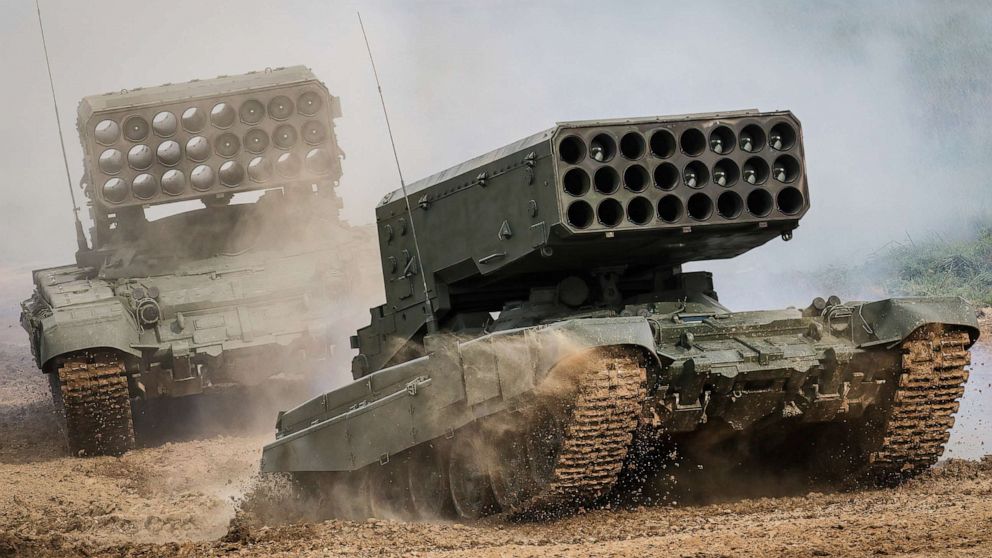What is the thermobaric weapon, better known as the 'vacuum bomb'? - 5 minutes read

Russia and the United States have both used thermobaric weapons in previous conflicts and have been in a decades-long race to refine the artillery, but Russia's alleged deployment of the so-called "vacuum bomb" on Ukrainian forces has prompted widespread backlash and fears that it will be used on civilians.
Oksana Markarova, Ukraine's ambassador to the United States, was the first to publicly accuse Russia of launching a thermobaric weapon on Ukrainian forces, killing 70 soldiers.
A senior U.S. Department of Defense official said the United States has yet to corroborate Markarova's accusations. Meanwhile, the United Kingdom Ministry of Defense claimed the Russian Ministry of Defense confirmed its forces' use of the weapon in Ukraine but did not provide details on when and where that occurred, or say how it verified the information.
"The Russian MoD has confirmed the use of the TOS-1A weapon system in Ukraine. The TOS-1A uses thermobaric rockets, creating incendiary and blast effects," the United Kingdom Ministry of Defense said in a tweet that was accompanied by a video explaining the weapon's devastating capabilities.
"We have seen the reports. If that were true, it would potentially be a war crime," White House press secretary Jen Psaki said during a Feb. 28 press briefing.
In this file image, Russian Army TOS-1A "Solntsepyok (Blazing Sun)" multiple rocket launcher and thermobaric weapon mounted on a T-72 tank chassis are seen during the annual Army Games defense technology international exhibition in Moscow, Aug. 25, 2021. The International Army Games is an annual Russian military sports event organized by the Ministry of Defense of Russia.
While no evidence has publicly surfaced that Russia has used thermobaric weapons on civilians in Ukraine, Russia has been accused by Ukrainian officials of using other weapons to attack civilians, including at a maternity hospital in the city of Mariupol in southeast Ukraine. Russian forces were also accused by Ukraine President Volodymyr Zelenskyy of bombing a dormitory building in the northern Ukraine city of Zhytomyr.
The Biden administration publicly warned Wednesday that as Russia continues to meet stiff resistance in Ukraine, the Kremlin might seek to up the ante and use chemical or biological weapons.
What is a thermobaric weapon?
A scale model of a TOS-1A Solntsepyok multiple rocket launcher and thermobaric weapon by UralVagonZavod Research and Development Corporation is on display at the IDEX 2021 International Defence Exhibition Conference in Abu Dhabi, U.A.E., Feb. 21, 2021.
Thermobaric weapons pack a devastating one-two punch, according to experts. First, a detonation unleashes a foreboding vaporized cloud of fuel that can penetrate small crevices and even underground bunkers before a second ignition charge creates a very hot mid-air blast that depletes the surrounding air of oxygen, thus the nickname "vacuum bomb."
Russia deployed the weapon in Chechnya in the 1990s and over the past decade in Syria. The United States used the weapon in Vietnam in the 1960s and most recently in Afghanistan in 2017.
"It's a particularly nasty weapon. It's a terrible way to die. It has a really broad effect and is probably most useful against hardened facilities," John Tierney, executive director at the Center for Arms Control Non-Proliferation in Washington, D.C., told ABC News.
Tierney, a former Massachusetts congressman who served on the House Intelligence Committee, said that if Russia ever uses a thermobaric weapon in a Ukrainian city, "It's going to be hard to miss civilians with it," explaining the explosive vaporous fuel cloud settles on everything, including people.
Tierney said the purported use of the bomb by Russia could be a sign of how desperate Russian President Vladimir Putin is to break the will of the Ukrainian people.
"You can't say what's going on in his mind, but it would seem to indicate that he's getting a little desperate, that things aren't going the way he planned," Tierney said.
TOS-1A Solntsepyok (Blazing Sun) with multiple thermobaric rocket launchers participate in the Victory Day military parade in Red Square marking the 75th anniversary of the victory in World War II, on June 24, 2020 in Moscow, Russia.
The United States and Russia have reportedly been in a race to perfect the thermobaric weapon, billed as a substitute to nuclear weapons.
Tierney said Russia's largest thermobaric weapon, tested in 2007, is believed to have packed the equivalent of 44 tons of TNT. By comparison, U.S. strategic nuclear weapons yield the equivalent of 50,000 tons to 1.2 megatons of TNT.
The destruction radius of a thermobaric explosion is estimated to be about 1,000-feet-wide but can have a blast area of up to 6,500 feet, according to a 2018 report from the U.S. Army War College.
In 2017, the Pentagon announced U.S. forces targeting an ISIS cave complex in eastern Afghanistan used a 22,000-pound thermobaric bomb nicknamed "the mother of all bombs." Formally known as the GBU-43, or massive ordnance air blast (MOAB) bomb, it was developed in 2003.
"Accurate casualty totals were impossible to calculate because any living thing close to the blast area was vaporized," a U.S. Army War College report said in describing the 2017 MOAB bomb drop in Afghanistan.
Source: ABC News
Powered by NewsAPI.org